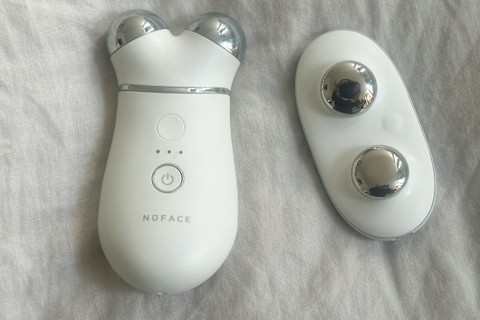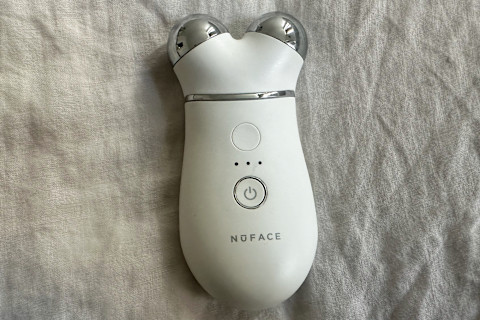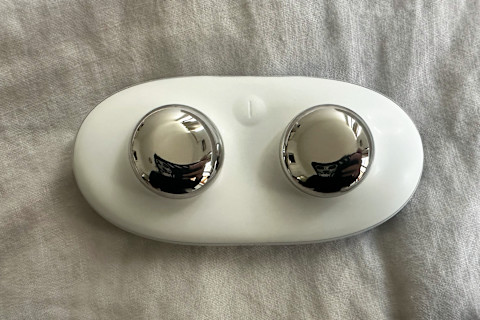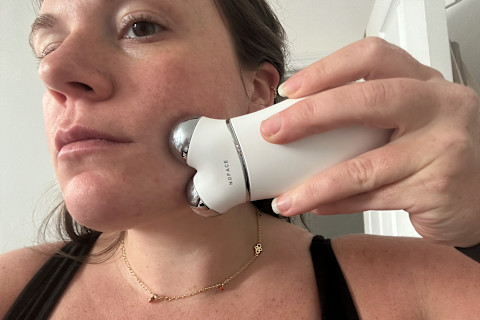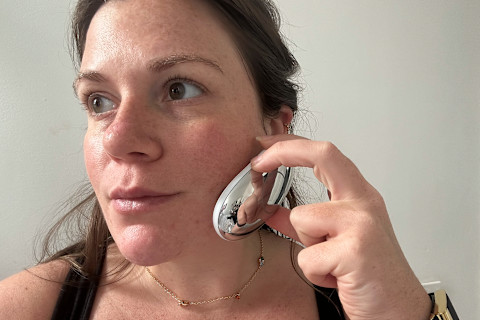I've seen the benefits of a microcurrent device firsthand. They can lift and tone aging skin, leading to fine line reduction and a more sculpted look. But they're also investment—for both your time and money—which makes finding the right option that much more important.
Here's what to know about these two high-tech handheld tools before making your purchase. Plus, which tool I'd recommend based on my tenure as a beauty director.
What you need to know before you read
What you need to know before you read
Microcurrent devices send small (micro) electrical currents into the skin and facial muscle. Microcurrent tools are typically hand-held devices, but professional-grade ones can be much larger. They also must be used with water-based conductor gels.
These currents mimic the same ones your brain sends to your facial muscles, according to biomedical engineer and holistic skin care expert Pooja Johari, M.S..
”What that means is our brains use currents to communicate through our neurological pathways, where it's constantly sending signals. What we're doing with this technology is mimicking those currents and delivering them to our facial muscles,” she says, noting that the muscles can’t discern if the signals are coming from the brain or via external sources.
And in stimulating the muscles through these tiny currents, a few things happen. The first is that the muscles are engaged and strengthened. This is why microcurrent devices often get billed as “workouts for your face.”
But it also stimulates adenosine triphosphate (ATP) production. ATP is a molecule that's naturally produced in the body, and plays a vital role in cellular energy. ATP is essentially the cell’s energy currency—transferring and moving energy throughout the body.
The skin and muscles use it as part of the natural regenerative process, creating more collagen, elastin, and so on.
ATP production declines with age—and so with it, a decline in overall cellular energy. More and more, beauty tools and topicals are being designed to up-regulate ATP production because of this. Including, yes, microcurrent devices.
- Sculpts & tones: Aging isn’t just about aesthetic changes to the epidermis—it’s about what’s happening underneath, too. Facial muscles weaken as we get older (as do all muscles), which can mean asymmetries and less defined features. By stimulating and strengthening the facial muscles, the tools can help tone and sculpt the appearance of the face.
- Improves cellular energy: Given microcurrents improve ATP production, the driving force of energy at the cellular level, you’ll see improved cellular energy and health. ATP is used in the rejuvenation process, so skin will rejuvenate faster. Research even indicates that this can improve wound healing.
- Smoothes fine lines & tightens skin: Collagen and elastin are the skin’s structural proteins, keeping the face firm and smooth. (With their natural decline, we see fine lines and sagging.) By improving the production process, microcurrent devices can help reduce the appearance of wrinkles and keep skin taut. One clinical study with 30 women under the age of 45 found that with 30 consecutive sessions (each session being 20 minutes), participants reported improved skin appearance and reduced wrinkle depth.
- Enhances ingredient penetration: The products you use while using the microcurrent tool are very important, as the tool helps ingredients penetrate the epidermis deeper. This means products can be made more effective. It can also trigger side effects if the ingredients used are too potent, and it can irritate the skin. So be mindful of what you’re using.
Summary:
What you need to know about NuFace
As someone who uses a microcurrent tool regularly, I've discovered a few helpful ways to find the right device for you. It's important to consider how often you plan to use it, as well as whether you plan to take it on the go. Beyond efficacy, I also think it's important to consider both upfront cost (the device) and ongoing costs (conductive gels).
Due to the similarity of the technology of the ZIIP and NuFace, I don't think you should buy both. That being said, I already own the ZIIP so I don't have a NuFace in my collection. Instead used the NuFace on numerous occasions while testing for stories or attending events.
Below, find my rundown of both brands, as well as how they compare based on cost, versatility, efficacy, and usability.
- FDA cleared
- Yes
- Microcurrent levels
- 5
- Recommended use
- 5 minutes/ 5 days per week
- Additional tech
- LED light therapy, Infared
Pros & Cons
Pros & Cons
Pros
Several tools to pick from (with a wider range of price points)
Can purchase extra attachments, like an LED head and an eye & lip wand
3 strength modes & an extra power option
Cons
Bulky design makes it harder to travel with (however, the minis are more compact)
The device has an oval shape, with two spheres on top that hug the face. Currents are emitted from the two spheres, and there's a noticeable weight to the device.
You can feel the current running through the NuFace when it turns on, and a solo button on the device lets you increase the intensity of the microcurrents.
Along with using the brand's smart app to elevate your treatment, you can also opt into “house calls” or group tutorial master classes with education consultants should you want something more interactive.
A quick rundown of the brand's current microcurrent device offerings:
- NuFace Trinity+:This is the brand’s most advanced device. It includes three intensity settings, as well as a “boost button” that amps up 25% more microcurrent for areas where you want some extra toning power. It also has built-in bluetooth, which you can pair with the brand’s app for tutorials, reminders, and progress tracking. You can purchase additional attachments.
- NuFace Trinity Classic: This is the standard offering, which includes three intensity settings, and an option for added attachments.
- NuFace Mini+: A smaller version of the Trinity+ that has three intensity settings and app exclusive tutorials just in a more portable size. You can purchase additional attachments.
- NuFace Mini Classic: A travel-friendly version of the classic. You can purchase additional attachments.
- NuBODY: A body specific microcurrent device with an ergonomic design better equipped to cover larger and harder-to-reach areas of the body. It comes with an extra large bottle of conductor gel.
- FIX: Target smaller areas (lips, crows feet, forehead) with this thinner, pen-like tool. It comes with a mini conductor gel.
- FDA cleared
- Yes
- Conductive gel included
- Yes
- Installment payments allowed
- Yes
- Additional tech
- Nanocurrent
Pros & Cons
Pros & Cons
Pros
Includes both micro- and nanocurrent technology
High-end conductor gels available for purchase (but comes with a base gel)
Tutorials include both visual instructions and haptic feedback
Sleek design that travels well
Cons
Only 1 option to pick from
No available attachments
It’s gently curved with two spheres are on the inside. To use, it’s gripped almost like a cell phone. Past versions of the device, which are no longer sold, are the GX and OX were slightly larger.
While ZIIP doesn’t offer multiple versions or attachments, it does use both microcurrents and (even smaller) nanocurrents. This dual-wave technology means that it’s more effective at the cellular level.
While microcurrents can improve ATP production, the main benefits are muscle-toning. Whereas with nanocurrent, you’re more effectively targeting the cellular changes. Nanocurrents are also usually better suited for those with sensitive skin.
I find the ZIIP to be way lighter than the NuFace device, but you can't feel the microcurrents running through it like you can with the NuFace. There's also only one button the device to lead you through a basic routine—so the ZIIP is best used with the brand's Halo App.
On the app you’ll find six full facials, 6 targeted treatments, and 3 treatment plans. The app guides you through these sessions with visual tutorial, while the tool gives haptic feedback to let you know when to move to the next section of skin.
The brand offers four different conduction gels. The base is an Electric Complex Gel, which is a very simple and gentle conduit gel for currents. However, they also offer more sophisticated offerings, such as the Golden Gel, Silver Gel, and Crystal Gel.
Comparing NuFace vs. ZIIP
These are two high-quality microcurrent device companies that share a lot of similarities—and a few notable differences.
Use-ability
NuFace
Products and tools won’t work if you don’t commit to them. This is true of all skin care, but especially true of microcurrent devices. They only work (and you’ll only see results) if you stick with the program—so I think it's important for the devices to be user-friendly.
The NuFace Trinity+ has an oval base (where you grip it), and the two spheres on top. If you get the attachments, you’d pop them over the spheres. When using, you’ll hold the device at the bottom and move it around your face.
The round base of the NuFace makes it easy to grip anywhere—which helps you reach odd angles or hit different parts of the face with more ease. But it’s a bit bulky, which isn't ideal for taking on the go.
While I recommend using the app to make the most of your NuFace, it's very easy to start playing with the device sans instructions. The solo button lets you easily adjust the intensity of the microcurrent to suit your needs.
I found even the highest setting didn't feel too intense with the microcurrent gel (though it will trigger a metallic taste when near your mouth). Recommended usage is 5 minutes per day for at least 5 days per week for best results.
ZIIP
The ZIIP HALO has a naturally smaller design that’s just about the size of an average palm. It’s curved with the spheres on the inside and a single button. I think the best way to hold it is like a cell phone.
Compared to the NuFace, it's super lightweight and compact. Plus, the ergonomic and familiar design moves around the face very easily.
Again, this should be paired with the user-friendly app. When you pick your facial (there are 6 full face options and 6 targeted sessions), it’ll work with the device and deliver sensory feedback so you know when to move onto a different area of the face.
With the app, the ZIIP is actually easier to use because the device gives feedback to help you follow along. However, I would argue that this device needs app tutorials for beginners while the NuFace feels a little more intuitive.
Unlike the NuFace, you only need to use this device 3 times per week to see results and the baseline facial is only about 4 minutes.
Winner
Cost
NuFace
The NuFace Trinity+ is the most expensive offering from NuFace at $395 for the starter kit. If you want the complete set (it includes the works), it’s $595.
However, the brand has other options such as the Trinity+ Mini ($250), the Classic ($350), the Classic Mini ($220), and a much smaller facial toning pen called the FIX ($165).
So all-in-all you should expect to pay anywhere from $165 to $595 when choosing something from NuFace. Attachments are $160 each. The skin care products are much more affordable, ranging from $12 to $65 per item.
ZIIP
Winner
Accessories
NuFace
NuFace device can be used with two attachments: a red light LED panel and an Eye & Lip attachment. Each attachment costs $160 or can be purchased as part of the brand's set.
I'm a huge fan of red LED light therapy to help improve collagen production, soothe inflammation, and strengthen the skin barrier—so I love that it's an option. That being said, I do think there are easiest ways to integrate the practice into your routine, like LED masks.
On the other hand, the eye and lip attachment is an interesting addition. It changes the spheres into two target wands for more precise usage, which is nearly impossible with the standard design.
ZIIP
The ZIIP does not have any extras or attachments.
Winner
Conductive gels & skincare
NuFace
NuFace offers two conductive gels and three boosters (which you’ll layer under the conductive gel). The conductive gels are soothing and hydrating, using high-quality ingredients such as hyaluronic acid, marine extracts, and botanical extracts.
They both also feature a complex that uses glacial water and ions to help enhance the microcurrents. As for the boosters, there’s a vitamin C concentrate, an antioxidant concentrate, and a peptide concentrate.
The basic conductive gel is relatively light, and it doesn't feel heavy on your face. That being said, you have to layer on more to ensure you don't feel the tingle of the device.
ZIIP
The ZIIP offers four different gel formulas, including a baseline gel (which is a very simple formula included with your purchase), as well as more high-end options.
I've used both the baseline formula and the Silver. I will warn the baseline formula just feels heavy, and I would recommend washing it off after your treatment.
Winner
Power, efficacy, and results
NuFace
The Trinity+, being the most advanced version from the brand, carries just about the same amount of power with 340 microamps at its highest setting. It has three power modes, as well as a booster button, which increases the power 25% on areas where you might need it more.
As former beauty editor Jamie Schneider wrote about in our full NuFace review, “After just two weeks of consistent use, I definitely notice a more lifted, contoured appearance.
See, I’m someone who typically wakes up with super puffy eyes and a swollen jawline—both woes went away immediately after a couple rounds of microcurrent. Better yet, I was waking up less puffy to begin with, I suspect as my facial muscles started toning up. My partner also commented on how my cheeks looked more chiseled, and I promise it was unprovoked.”
You’ll also likely get more skin care benefits if you opt to include the LED attachment, as that works on the epidermis. With it, you can also expect to see a more even tone, reduced inflammation, and a brighter complexion—things that you won’t see with microcurrent devices otherwise.
ZIIP
Microcurrents primarily target the muscle, whereas nanocurrents work more effectively at the cellular level, stimulating ATP, collagen, and elastin production.
This can help drive more long-term skin care-focused results, rather than just improving facial muscles and overall toning.
I’ve used ZIIP consistently for a while now (I don’t follow a program, but do try to do it 1-2 times a week), and I count it as one of the reasons my face remains lifted and defined as I get older.
I’ve been using it proactively and preventatively, so there was nothing to “reverse,” but considering I often get mistaken for ages years younger than I am, I do think it’s helping.
Winner
Our verdict: NuFace vs. ZIIP
Again, I’d like to emphasize that you cannot go wrong with either of these brands or devices. They’re two of the highest quality microcurrent makers on the market, and I back both of them wholeheartedly.
NuFace offers much more variety, lower price points, skin care options, and extra tech attachments—which makes the overall result more customizable to your needs. This is probably a better fit for a beginner who is still figuring out what exactly they’re looking for in the world of skin care tools.
ZIIP, however, stands out with power and nanocurrent technology. For those who are serious about their microcurrent devices, this is a worthy fit.
Just a reminder before you buy
While microcurrent facial devices are generally considered safe for most, these are professional-grade products and should be treated with care.
First and foremost, check with your practitioner about using them if you have epilepsy, heart conditions, or are pregnant, celebrity esthetician Shani Darden once warned us. You should also avoid it if you have a pacemaker.
In addition, they may cause increased flushing or redness in individuals who have rosacea. So proceed with caution, and avoid using it during flare ups or on areas prone to redness.
They should also not be used on open wounds, acne liaisons, or areas experiencing a breakout. Finally, they won’t be effective on areas where you have facial hair.
As we’ve noted above, microcurrents help enhance ingredient penetration. This is a good thing—except for when it’s not. If you pair your microcurrent with too powerful or potentially irritating ingredients, it can trigger inflammation.
Avoid AHAs, BHAs, retinols, as well as any ingredient you know to be personally irritating to you. (And on that note: always check the ingredient list of the conductive gel to see if there are any ingredients that you have sensitivities to.)
FAQ
What is the difference between nanocurrent and microcurrent?
Nanocurrents are even smaller electrical currents than microcurrents. Microcurrents primarily target the muscle, whereas nanocurrents work more effectively at the cellular level, stimulating ATP, collagen, and elastin production.
Does ZIIP and NuFace stimulate collagen?
Both the NuFace and ZIIP can stimulate collagen production thanks to their ability to enhance ATP production. However, ZIIP is likely more effective at it given the device utilizes nanocurrent technology.
How does ZIIP compare to NuFace?
Both are excellent microcurrent manufacturers, and worth of an investment. You can’t go wrong with whatever one you pick! If variety is what you’re looking for, NuFace might be the better selection as you can use additional attachments such as the LED panel. But with ZIIP, you’ll reap the benefits of nanotechnology, which is better suited for targeting cellular health.
The takeaway
Microcurrent devices are a worthy addition to your skin care routine—if you’re willing to pay for it, and stick with it to see results. The ZIIP HALO and NuFace Trinity+ are two of the best options on the market and are highly effective. The NuFace Trinity+ outshines the ZIIP HALO thanks to it’s booster mode and ability to purchase extra attachments, but the ZIIP’s nanocurrent technology means you’ll see results at the cellular level.
All in all, both are excellent. But if variety is what you’re looking for, NuFace Trinity+ might be the better selection. However, I personally use the ZIIP HALO so I can reap the benefits of nano tech.

